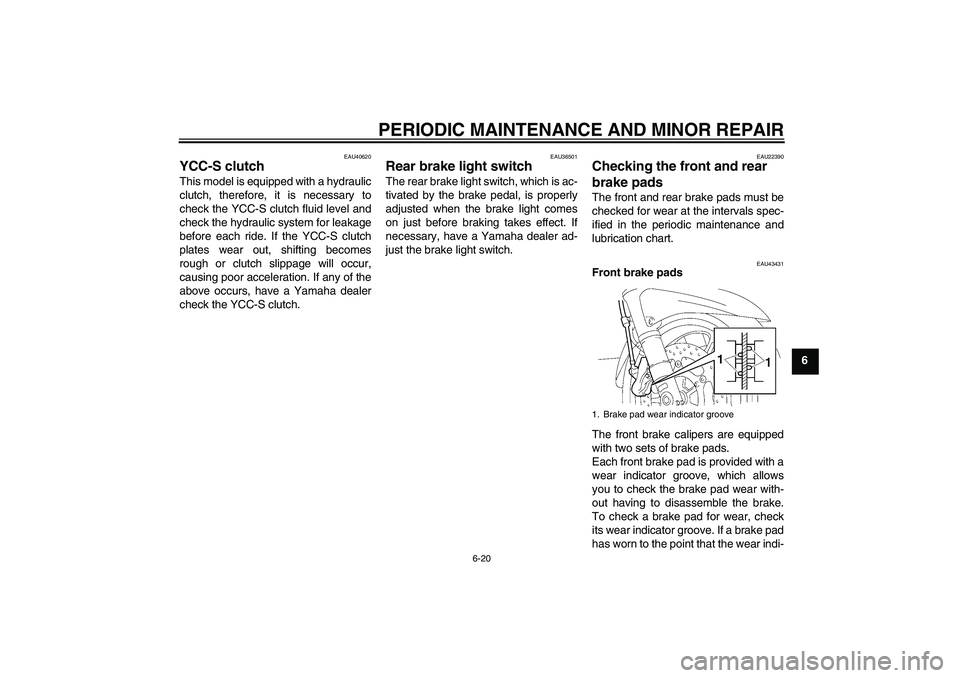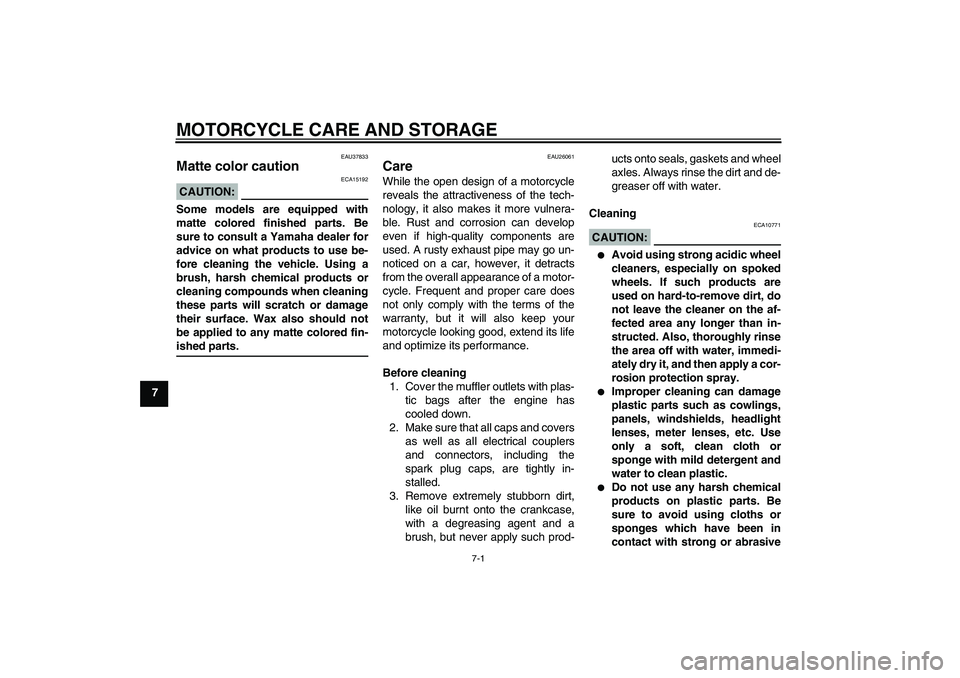Page 69 of 104

PERIODIC MAINTENANCE AND MINOR REPAIR
6-12
6 10. Start the engine, and then let it idle
for several minutes while checking
it for oil leakage. If oil is leaking, im-
mediately turn the engine off and
check for the cause.
NOTE:After the engine is started, the engine
oil level warning light should go off if theoil level is sufficient.CAUTION:
ECA10400
If the oil level warning light flickers
or remains on, immediately turn the
engine off and have a Yamaha dealercheck the vehicle.11. Turn the engine off, and then
check the oil level and correct it if
necessary.
EAU20014
Final gear oil The final gear case must be checked
for oil leakage before each ride. If any
leakage is found, have a Yamaha deal-
er check and repair the vehicle. In addi-
tion, the final gear oil must be changed
as follows at the intervals specified in
the periodic maintenance and lubrica-
tion chart.
WARNING
EWA10370
�
Make sure that no foreign mate-
rial enters the final gear case.
�
Make sure that no oil gets on thetire or wheel.
To check the final gear oil level
1. Place the vehicle on the center-
stand.
NOTE:�
The final gear oil level must be
checked on a cold engine.
�
Make sure that the vehicle is posi-
tioned straight up when checking
the oil level. A slight tilt to the sidecan result in a false reading.
1.“CD” specification
2.“ENERGY CONSERVING II”
1
2
U2D2E2E0.book Page 12 Thursday, October 11, 2007 9:15 AM
Page 71 of 104

PERIODIC MAINTENANCE AND MINOR REPAIR
6-14
6
EAU20070
Coolant The coolant level should be checked
before each ride. In addition, the cool-
ant must be changed at the intervals
specified in the periodic maintenance
and lubrication chart.
EAU39512
To check the coolant level
The coolant level should be checked as
follows before each ride. In addition,
the coolant must be changed at the in-
tervals specified in the periodic mainte-
nance and lubrication chart.
1. Place the vehicle on the center-
stand.NOTE:�
The coolant level must be checked
on a cold engine since the level
varies with engine temperature.
�
Make sure that the vehicle is posi-
tioned straight up when checking
the coolant level. A slight tilt to theside can result in a false reading.
2. Check the coolant level in the cool-
ant reservoir.
NOTE:The coolant should be between theminimum and maximum level marks.
3. If the coolant is at or below the
minimum level mark, remove the
coolant reservoir cap.4. Add coolant or distilled water to
raise the coolant to the maximum
level mark, install the coolant res-
ervoir cap.
CAUTION:
ECA10471
�
If coolant is not available, use
distilled water or soft tap water
instead. Do not use hard water
or salt water since it is harmful
to the engine.
�
If water has been used instead
of coolant, replace it with cool-
ant as soon as possible, other-
1. Maximum level mark
2. Minimum level mark
1. Coolant reservoir cap
Coolant reservoir capacity (up to the
maximum level mark):
0.25 L (0.26 US qt) (0.22 Imp.qt)
U2D2E2E0.book Page 14 Thursday, October 11, 2007 9:15 AM
Page 77 of 104

PERIODIC MAINTENANCE AND MINOR REPAIR
6-20
6
EAU40620
YCC-S clutch This model is equipped with a hydraulic
clutch, therefore, it is necessary to
check the YCC-S clutch fluid level and
check the hydraulic system for leakage
before each ride. If the YCC-S clutch
plates wear out, shifting becomes
rough or clutch slippage will occur,
causing poor acceleration. If any of the
above occurs, have a Yamaha dealer
check the YCC-S clutch.
EAU36501
Rear brake light switch The rear brake light switch, which is ac-
tivated by the brake pedal, is properly
adjusted when the brake light comes
on just before braking takes effect. If
necessary, have a Yamaha dealer ad-
just the brake light switch.
EAU22390
Checking the front and rear
brake pads The front and rear brake pads must be
checked for wear at the intervals spec-
ified in the periodic maintenance and
lubrication chart.
EAU43431
Front brake pads
The front brake calipers are equipped
with two sets of brake pads.
Each front brake pad is provided with a
wear indicator groove, which allows
you to check the brake pad wear with-
out having to disassemble the brake.
To check a brake pad for wear, check
its wear indicator groove. If a brake pad
has worn to the point that the wear indi-1. Brake pad wear indicator groove
U2D2E2E0.book Page 20 Thursday, October 11, 2007 9:15 AM
Page 86 of 104

PERIODIC MAINTENANCE AND MINOR REPAIR
6-29
6
If a fuse is blown, replace it as follows.
1. Turn the key to “OFF” and turn off
the electrical circuit in question.2. Remove the blown fuse, and then
install a new fuse of the specified
amperage.
CAUTION:
ECA10640
Do not use a fuse of a higher amper-
age rating than recommended to
avoid causing extensive damage to
the electrical system and possibly afire.
3. Turn the key to “ON” and turn on
the electrical circuit in question to
check if the device operates.
4. If the fuse immediately blows
again, have a Yamaha dealer
check the electrical system.
1. Fuse box
2. Right radiator fan fuse
3. Left radiator fan fuse
4. Hazard fuse
5. Backup fuse (for odometer, clock and immo-
bilizer system)
6. ABS solenoid fuse
7. Fuel injection system fuse
8. Headlight fuse
9. Signaling system fuse
10.ABS control unit fuse
11.Ignition fuse
12.Auxiliary DC jack fuse
13.YCC-S motor control fuse
14.Spare fuse
20
0
2
714
8 9
10 11
12 13
Specified fuses:
Main fuse:
50.0 A
Headlight fuse:
25.0 A
Signaling system fuse:
15.0 A
Ignition fuse:
10.0 A
Radiator fan fuse:
15.0 A × 2
Backup fuse:
10.0 A
Hazard fuse:
10.0 A
Fuel injection system fuse:
15.0 A
ABS solenoid fuse:
20.0 A
ABS control unit fuse:
10.0 A
Auxiliary DC jack fuse:
3.0 A
ABS motor fuse:
30.0 A
YCC-S motor control fuse:
30.0 A
U2D2E2E0.book Page 29 Thursday, October 11, 2007 9:15 AM
Page 87 of 104
PERIODIC MAINTENANCE AND MINOR REPAIR
6-30
6
EAU40360
Headlight bulb If a headlight does not come on, have a
Yamaha dealer check its electrical cir-
cuit or replace the bulb.
EAU39880
Front turn signal light If a front turn signal light does not come
on, have a Yamaha dealer check its
electrical circuit or replace the bulb.
EAU27001
Replacing a rear turn signal
light bulb or a tail/brake light
bulb 1. Remove the passenger seat. (See
page 3-22.)
2. Remove the socket (together with
the bulb) by turning it counter-
clockwise.
3. Remove the defective bulb by
pushing it in and turning it counter-
clockwise.
4. Insert a new bulb into the socket,
push it in, and then turn it clock-
wise until it stops.
5. Install the socket (together with the
bulb) by turning it clockwise.1. Turn signal light bulb socket
2. Tail/brake light bulb socket
U2D2E2E0.book Page 30 Thursday, October 11, 2007 9:15 AM
Page 88 of 104
PERIODIC MAINTENANCE AND MINOR REPAIR
6-31
66. Install the passenger seat.
EAU24310
Replacing the license plate
light bulb 1. Remove the license plate light unit
by removing the screws.
2. Remove the socket (together with
the bulb) by pulling it out.3. Remove the defective bulb by pull-
ing it out.
4. Insert a new bulb into the socket.
5. Install the socket (together with the
bulb) by pushing it in.
6. Install the license plate light unit by
installing the screws.1. Screw
2. License plate light unit
1. License plate light bulb
U2D2E2E0.book Page 31 Thursday, October 11, 2007 9:15 AM
Page 89 of 104

PERIODIC MAINTENANCE AND MINOR REPAIR
6-32
6
EAU39020
Auxiliary light bulb If the auxiliary light does not come on,
have a Yamaha dealer check the elec-
trical circuit or replace the bulb.
EAU25870
Troubleshooting Although Yamaha motorcycles receive
a thorough inspection before shipment
from the factory, trouble may occur dur-
ing operation. Any problem in the fuel,
compression, or ignition systems, for
example, can cause poor starting and
loss of power.
The following troubleshooting charts
represent quick and easy procedures
for checking these vital systems your-
self. However, should your motorcycle
require any repair, take it to a Yamaha
dealer, whose skilled technicians have
the necessary tools, experience, and
know-how to service the motorcycle
properly.
Use only genuine Yamaha replace-
ment parts. Imitation parts may look like
Yamaha parts, but they are often inferi-
or, have a shorter service life and can
lead to expensive repair bills.
U2D2E2E0.book Page 32 Thursday, October 11, 2007 9:15 AM
Page 92 of 104

MOTORCYCLE CARE AND STORAGE
7-1
7
EAU37833
Matte color caution CAUTION:
ECA15192
Some models are equipped with
matte colored finished parts. Be
sure to consult a Yamaha dealer for
advice on what products to use be-
fore cleaning the vehicle. Using a
brush, harsh chemical products or
cleaning compounds when cleaning
these parts will scratch or damage
their surface. Wax also should not
be applied to any matte colored fin-ished parts.
EAU26061
Care While the open design of a motorcycle
reveals the attractiveness of the tech-
nology, it also makes it more vulnera-
ble. Rust and corrosion can develop
even if high-quality components are
used. A rusty exhaust pipe may go un-
noticed on a car, however, it detracts
from the overall appearance of a motor-
cycle. Frequent and proper care does
not only comply with the terms of the
warranty, but it will also keep your
motorcycle looking good, extend its life
and optimize its performance.
Before cleaning
1. Cover the muffler outlets with plas-
tic bags after the engine has
cooled down.
2. Make sure that all caps and covers
as well as all electrical couplers
and connectors, including the
spark plug caps, are tightly in-
stalled.
3. Remove extremely stubborn dirt,
like oil burnt onto the crankcase,
with a degreasing agent and a
brush, but never apply such prod-ucts onto seals, gaskets and wheel
axles. Always rinse the dirt and de-
greaser off with water.
Cleaning
CAUTION:
ECA10771
�
Avoid using strong acidic wheel
cleaners, especially on spoked
wheels. If such products are
used on hard-to-remove dirt, do
not leave the cleaner on the af-
fected area any longer than in-
structed. Also, thoroughly rinse
the area off with water, immedi-
ately dry it, and then apply a cor-
rosion protection spray.
�
Improper cleaning can damage
plastic parts such as cowlings,
panels, windshields, headlight
lenses, meter lenses, etc. Use
only a soft, clean cloth or
sponge with mild detergent and
water to clean plastic.
�
Do not use any harsh chemical
products on plastic parts. Be
sure to avoid using cloths or
sponges which have been in
contact with strong or abrasive
U2D2E2E0.book Page 1 Thursday, October 11, 2007 9:15 AM